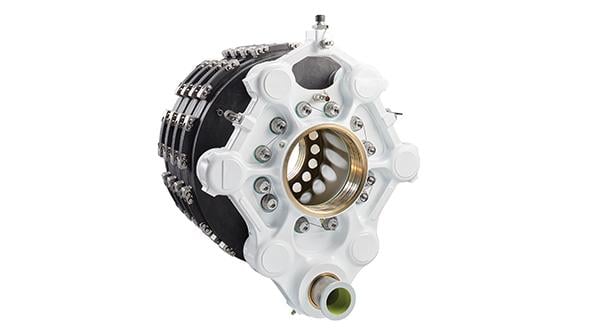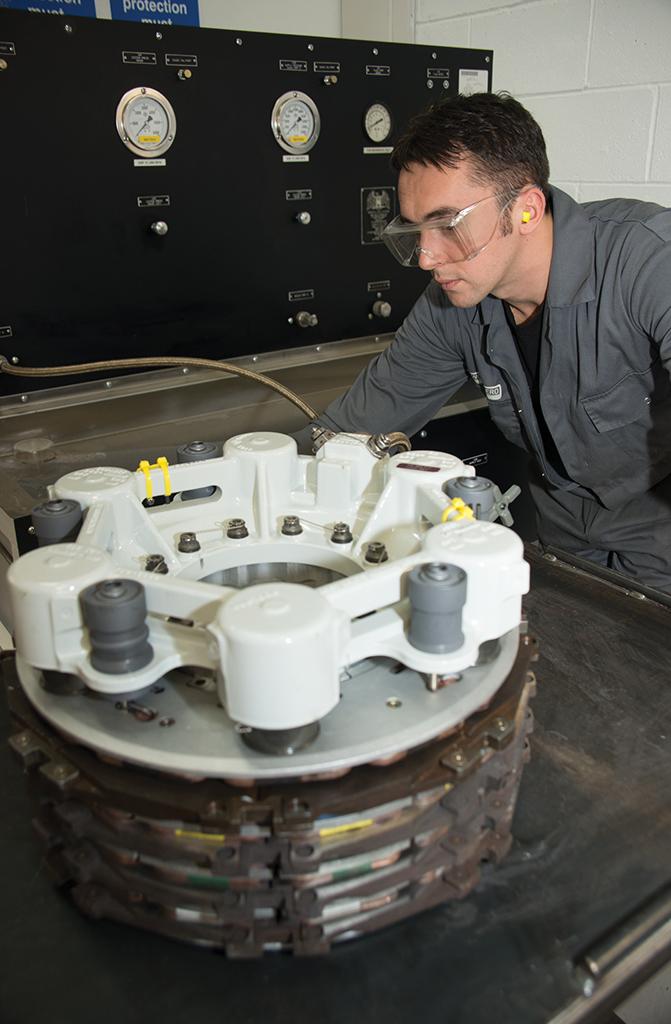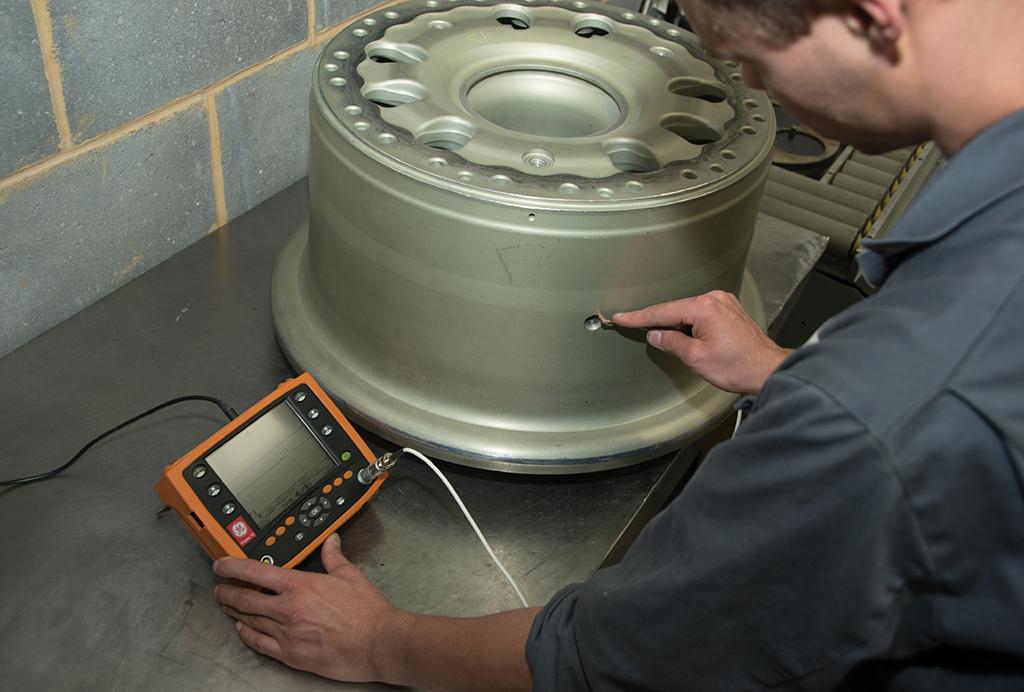
Aircraft brakes are becoming greener and cleaner, along with providing greater life on-wing.
“For the next-generation aircraft, the builders are looking toward electric brake actuation [eBrake], as well as a desire to have more environmentally friendly components within the braking system,” says Jason Muldoon, director of offering management-wheels and brakes at Honeywell Aerospace. “This is in addition to the industry’s pursuit of longer-lasting products, minimizing maintenance costs.”
Although, as Muldoon points out, both carbon and steel continue to be the primary materials used for brakes, all new programs have moved more to carbon and away from steel braking systems. Honeywell, he explains, is focusing on its carbon manufacturing processes to develop a long-lasting carbon heat sink, and is concentrating on increasing the life of the material set currently in use, which will allow longer time between overhauls. Among the reasons he gives for this preference is a greater resistance to damage from the heat generated when the brakes are applied.
While Muldoon says he cannot go into specific detail about the technology involved, citing proprietary reasons, he did note that the current technology upgrades “are giving us estimates of 20% or greater extended life between overhauls.”
As for retrofits involving the installation of new-generation brakes, Muldoon says Honeywell is in the final approval process for the conversion of its legacy brake used on the Airbus A330ceo to its Carbenix brake, for use on both the A330ceo and A330neo. Carbenix, as Honeywell describes it, incorporates the OEM’s latest generation of carbon friction materials along with an advanced integrated design and patented anti-oxidant protection. Its benefits are enhanced durability, greater stopping performance, reduced weight and lower cost.
Honeywell, Muldoon adds, is also in the process of developing an eBrake product which, he notes, eliminates hydraulic application and offers longer service.

“We don’t have a specific timeline we can share right now, but we plan to be ready for any eBrake application to any new aircraft coming out,” he says. “We are also working to use our avionics expertise to develop data-connected opportunities within the braking system, though it would be premature to comment about what specific data would be generated and retrieved at this time.”
Reducing operating costs continues to be a major goal for brake OEMs, says Satish Narayanan, executive director, engineering-landing systems for Collins Aerospace. This, he explains, can be accomplished by increasing the number of landings for which the brake remains on the aircraft, and making braking systems simpler to maintain when they come into a shop for servicing.
“Reliability continues to be another driver for cost reduction, especially as our customers support larger and more diverse fleets,” says Narayanan, who notes that “sustainability” is another focus area for Collins Aerospace. “That means making products which are recyclable, energy-efficient and electric.”
Narayanan says improving a landing gear’s ability to manage increased loads is driving the need for much more durable and lightweight structures. “The increased thermal energies felt by the brakes during landing also drives the need for materials that are better at managing dissipation of the energy and do not degrade with sustained exposure to high temperatures,” he points out.
Asked about trends involving wheel and brake materials, Narayanan says that the “most actively sought changes in materials” are directed at reducing system weight while improving durability. About this, he notes, Collins Aerospace sees great potential for composites—particularly thermoplastic composites—for use in landing gear structures.
“Better compositions of carbon composites and processing techniques are key to increasing the thermal capacity of our brakes while improving their life,” he stresses. “Lighter-weight alloys for wheels and other brake structures are also being explored.”
Narayanan confirms that wheel and brake developments at Collins include improved and optimized designs to maintain durability while lowering weight, the elimination of “materials of concern from an environmental perspective,” and the use of anti-corrosion materials and coatings.
“Examples include the brake assembly torque-plate component material change from steel to titanium to help reduce weight while also improving corrosion resistance,” he explains. “Another advance is the introduction of lock-ring wheel designs to improve maintainability by eliminating bolts.”
Narayanan points out that over the last decade, the use of carbon brakes has grown rapidly in comparison to brakes made with steel, largely due to the substantial weight reduction achieved. Citing the OEM’s Duracarb carbon friction material, he says weight savings can be as much as 200 lb. for a narrowbody brake, with an average 35% longer brake life over competing carbon materials.
Narayanan adds that material chemistries are also constantly evolving to enable heat sink materials to perform at higher operating temperatures and in harsher operating environments, which trigger oxidation-driven degradation of the material. “These material systems are called oxidation protection systems, or OPS coatings for short, and are applied during the production of the carbon material,” he explains.

Kurt Burkhalter, chief engineer for mechanical systems at Meggitt, reports that newer, higher-strength alloys are increasingly used in primary structural elements such as the brake housing and wheel halves, while material and coating changes have also been made to help reduce the environmental footprint.
“Newer, larger aircraft typically employ more carbon for heat sinks due to their weight savings, so the carbon [technology] continues to be developed, with newer materials offering improvements in performance and strength,” he says. “Improved anti-oxidation coatings applied to the carbon heat sink are essential for resisting the effects of high temperature as well as catalysts, which can find their way to the heat sink in service. In the case of the carbon heat sink materials, considerations around the re-use of the individual brake disks for a second overhaul have more of an influence on the design process.”
In fact, according to Burkhalter, the carbon brake heat sink is an area of development that can often offer the biggest impact in terms of overall weight efficiency of both the brake and the main wheel. But he also stresses that optimization of all wheel and brake components, using the latest analysis techniques, helps to develop more lightweight, robust products.
“As analysis and simulation techniques have become more capable over the years, they have been used to better optimize the design of wheel and brake parts for greater weight savings and robustness—primarily in the main wheel and brake, where the potential for the biggest weight and cost savings can be found,” Burkhalter notes.
“Weight reduction of wheel and brake components [is] definitely a key trend,” says Phil Randell, CEO of UK-headquartered World Aero. “Whereas wheels were heavy and almost indestructible, we are now seeing ever leaner, more delicate-looking equipment. But new materials and stronger structures ensure they are still robust.”
However, as Randell points out, that comes with a tradeoff. “There is no denying that newer, lighter components may have shorter life spans, but the efficiencies delivered and fuel savings tend to outweigh the additional costs of potentially higher rejection rates at overhaul.”
Randell adds that boltless wheels, currently used mainly on corporate aircraft, have been “revolutionary,” providing weight savings and easier inspections due to fewer parts. Even so, “With the exception of the C-130, boltless wheels have not taken off in the large aircraft sector,” he explains.

Paul Severin, executive vice president of AeroRepair, an aircraft wheel, brake and battery MRO specialist, says eBrakes could be the upcoming technology and gain wider usage, although to date, they are only flying commercially on the Boeing 787 and Airbus A220. He describes their advantages over hydraulic systems: “With hydraulic brakes, if there is a fluid leak, the entire wheel/brake assembly must be removed from the aircraft and the brake sent to a service facility for diagnostics and repair.”
In contrast, he says, if there is a problem with an electrically activated brake, all that is required is removal of the individual brake actuator control unit and replacement with a serviceable one at line level—in under an hour. “Removal and reinstallation of a hydraulic brake and wheel assembly takes about 3-4 hr. plus the loss of the brake assembly for use while it goes through the repair process,” he says.
Despite their beneficial features in comparison to hydraulic brakes, Severin cautions that he is not seeing a trend toward electrically actuated braking systems at this time. Other brake system MRO providers also share a cautious outlook. “We have not seen any of these brakes yet, but this is an area where we would look at developing our skills to fit this technology,” says Ismael Fadili, sales and marketing director at Antavia in France. “Right now, it is difficult to say if they are a trend.”
World Aero’s Randell suspects that a migration from hydraulic to eBrakes is likely in the not-too-distant future. “We can see this as the technology becomes more popular due to the benefits of eBrakes such as units that do not leak, and on-aircraft maintenance potential such as reducing AOG time.”
Meanwhile, AeroRepair’s Severin reports that technological developments with brakes will continue to concentrate on carbon brake performance, particularly with respect to oxidation resistance to improve on-wing life and lower operating costs for aircraft fleets.
“Oxidation is the number one enemy of carbon brakes,” he stresses. “Numerous advances have been made in oxidation resistance, especially now that the trend is away from steel heat sinks. Carbon is where the technology is focused,” Severin asserts.






